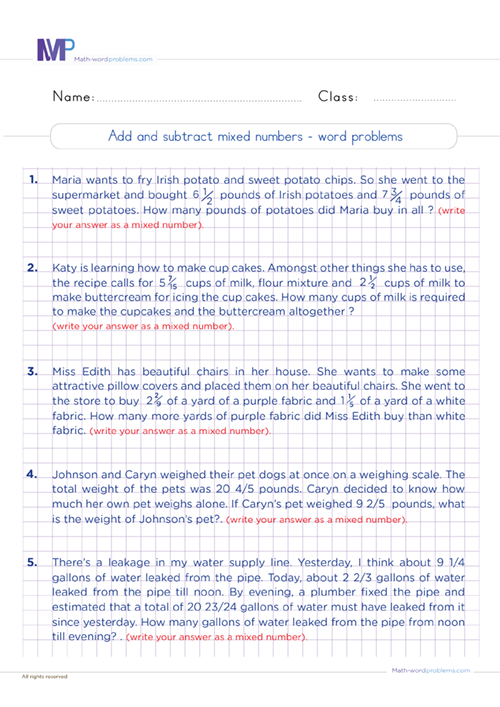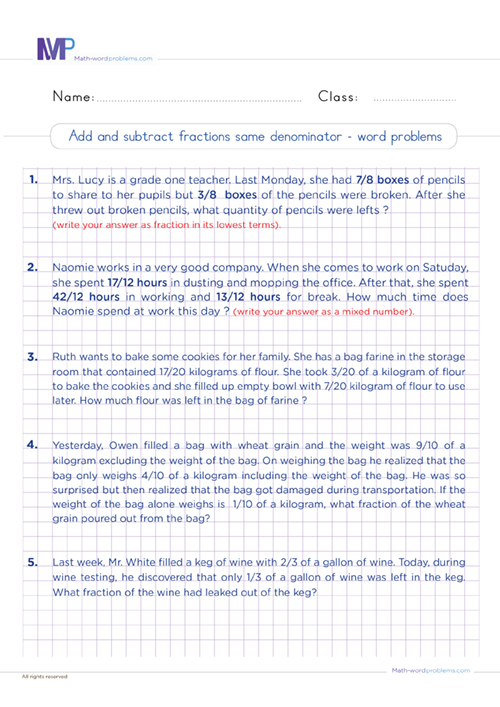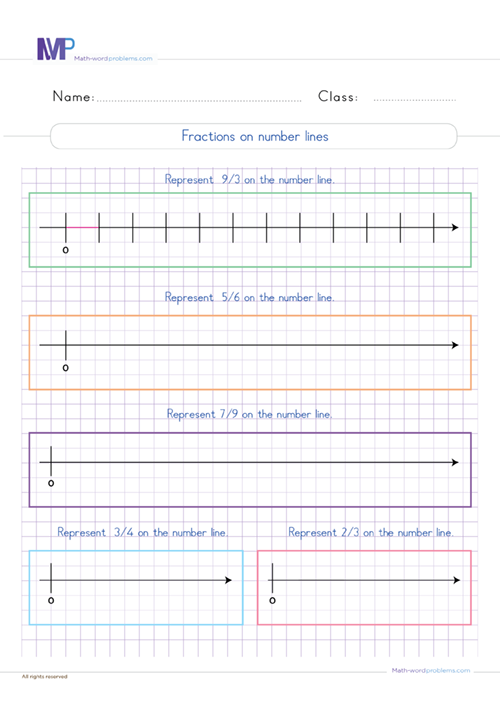 What is the easiest way to add and subtract mixed numbers in word problems?
What is the easiest way to add and subtract mixed numbers in word problems?

- INTRODUCTION
- Step 1 IDENTIFY
- Step 2 STRATEGIZE
- Step 3 SET UP
- Step 4 PROVIDE A SOLUTION
- Step 5 CHECK YOUR WORK
Get more contents on this skill...
Have you ever asked yourself what is the easiest way to add and subtract mixed numbers word problems? Well, here is a powerful, simple step-by-step guide to getting kids excited about solving these challenging yet enriching real-life grade six word problems.
Amazingly this guide has the best techniques that kids will use to have a quick mastery of word problems, no matter how complex they may seem. Furthermore, the fundamental purpose of this creative guide is to make the critical thinking required for solving word problems easier.
Steps to Solve Addition and Subtraction of Mixed Numbers Word Problems
We’ve got here remarkable steps to solve addition and subtraction of mixed numbers word problems quickly. This will make learners not only attempt every word problem they encounter but will provide complete and accurate solutions to word problems they will encounter with ease.
Furthermore, our main aim is to provide kids with the most straightforward yet technical strategy they can use to become great, skillful geniuses in solving math word problems.
Also, we’ve added real-life examples/situations to show kids how easy and fulfilling these steps are.
Step 1: IDENTIFY:
To identify or figure out the important mixed numbers and keywords in the word problem, you have to read the problem very well and understand it. Then use these keywords to identify whether the problem involves addition or subtraction.
- When it comes to adding mixed numbers word problems, the keywords you’ll likely come across are: - add, plus, more, total, in total, increase, together, Altogether, combined, sum, grow, join, both, in all, and, how many in all, how much, etc.
- Similarly, concerning subtracting mixed numbers word problems, these are the keywords you should expect to see in the word problem: - less, less than, excluding, minus, take away, left, decrease, difference, fewer, deduct, remain, change, how many more, left over, less than, how much longer/shorter, how much farther, fewer than, discount, etc.
- ***One key Element for learners to understand is that they should not always rely on keywords alone. That is to say; the same keyword can have different meanings in different word problems.
- For this reason, we reiterate on the importance of reading the question very carefully to understand the situation that the word problem is describing, then figure out exactly which operation to use***
Step 2: STRATEGIZE:
How will you decode or tackle the word problem?
- You will know from the keyword(s) in the word problem if you need to add or subtract or perform any other operation.
- Also, for addition and subtraction of mixed numbers, all fractions must have the same denominators. If your fractions already have the same denominator, then you are good to go. If not, you have to find the lowest common denominator (LCD) and write equivalent fractions with the LCD you just found. i.e., multiplying the given fractions by a suitable number to achieve fractions with the same denominator.
- Remember that you must not always depend only on keywords. Rather, try to read and understand the situation that the problem is describing.
- So after knowing the exact operation you will perform, Construct short expressions/sentences to represent the given word problem.
Step 3: SET UP:
Here, write down a numerical expression/ mathematical equation representing the information given in the word problem.
Step 4: PROVIDE A SOLUTION:
From Step 3 above, do the following to solve the word problem.
- Firstly, add or subtract the whole numbers in both mixed numbers together.
- Secondly, if the denominators of the mixed numbers are the same, simply add the numerators while keeping the denominator the same.
- Thirdly, if the denominators are not the same, find the LCD and write equivalent fractions with the LCD you just found by multiplying the given fractions by a suitable number in order to achieve fractions with the same denominator. Then, go ahead and add or subtract the fractions by adding or subtracting the numerators together while leaving the denominator the same.
- Also, simplify the fraction if possible.
- Finally, do not forget to add the unit of measurement to you final answer if any.
Step 5: CHECK YOUR WORK:
Examples on how to solve addition and subtraction of mixed numbers word problems.
Example one: How to subtract mixed numbers word problems.
Step 1: After reading the problem very carefully, these are the important mixed numbers that you’ll find 50
Step 2: Next, how will you solve the problem? From the scenario that the problem is presenting and the keyword “how much more”, it is clear that the question asks to find the difference of the given mixed numbers. Hence, this is a subtraction operation.
Then, after knowing which operation you are going to perform, create short expressions/sentences to represent the given word problem.
- Hectares of farm Allan has = 50
- Hectares of farm his friend has = 87
- Therefore, the hectares of farm his friend has more than him = the hectares of the farm his friend has – the hectares of farm his friend has.
Step 3: Now, write down a numerical expression/a mathematical equation to represent the bolded sentence in step 2 above:
87
Step 4: From Step 3 above, do the following to solve the mathematical equation representing the word problem.
- Firstly, subtract the whole numbers in both mixed numbers together.
- Secondly, since the denominators of the mixed numbers are the same, just go ahead and subtract the numerators while keeping the denominator the same.
- hirdly, simplify the fraction if possible.
- Lastly, remember to include the unit of measurement to your final answer if any
87
So, his friend has 37
Step 5: Finally, check out your work by interpreting the answer in the context of the problem. If the interpretation makes sense, then “YES,” you are done. If “NO,” go back to step 1 and start all over again.
Example two: How to subtract mixed numbers word problems.
Step 1: First, the important mixed numbers found after reading the problem and understanding it very well are 4
Step 2: Next, how will you solve the problem? From the keyword “left,” it is clear that the question asks to find the difference between the mixed numbers. Hence, you have to perform a subtraction operation.
Then, after knowing which operation you will perform, Construct short expressions/sentences to represent the given word problem.
- Boxes of candy he bought = 4
- Boxes of candy he ate = 1
- Therefore, the number of boxes of candy he has left = the boxes of candy he bought – the boxes of candy he ate.
Step 3: Now, write down a numerical expression to represent the bolded sentence in step 2 above:
4
Step 4: From Step 3 above, do the following to solve the word problem.
- Firstly, subtract the whole numbers in both mixed numbers together.
- Secondly, since the denominators are different, find the LCD of 4 and 5. Write equivalent fractions with the LCD you just found. i.e., by multiplying the given fractions by a suitable number to achieve fractions with the same denominator.
- Thirdly, subtract the fractions by subtracting the numerators together while leaving the denominator the same.
- Fourthly, simplify the fraction if possible.
- Lastly, remember to include the unit of measurement in your final answer if any
(Since 5 and 4 are all factors of 20; you can use 20 as the least common denominator)
4
So, he has 3
Step 5: Finally, check out your work by interpreting the answer in the context of the problem. If the interpretation makes sense, then “YES,” you are done. If “NO,” go back to step 1 and start all over again.
Example three: How to solve addition of mixed numbers word problems.
Step 1: First, after reading the question well, the important mixed numbers here are 2
Step 2: Next, how will you solve the problem? From the keyword “in all” found in the word problem and the situation that the problem is describing, it is clear that the question asks to find the sum of the given mixed numbers. Hence, you have to carry out an addition operation.
After knowing which operation you will perform, construct short expressions/sentences to represent the given word problem.
- Quantity of water he drank in the morning = 2
liters = 2 = 2 - Quantity of water he drank in the afternoon = 4
liters - Quantity of water he drank in the evening = 1
liter - Therefore, the quantity of water they drank in all = the quantity of water he drank in the morning + the quantity of water he drank in the afternoon + the quantity of water he drank in the evening.
Step 3: Now, write down a numerical expression/ a mathematical equation to represent the bolded sentence in step 2 above:
2
Step 4: Then, from Step 3 above, do the following to solve the word problem.
- Firstly, add the whole numbers in both mixed numbers together.
- Secondly, since the denominators of the mixed numbers are the same, add the numerators while keeping the denominator the same.
- Thirdly, simplify the fraction if possible.
- Lastly, remember to include the unit of measurement to your final answer if any
2
So, he drank 8
Step 5: Finally, check out your work by interpreting the answer in the context of the problem. If the interpretation makes sense, then “YES,” you are done. If “NO,” go back to step 1 and start all over again.
Example four: How to solve addition of mixed numbers word problems.
Step 1: Start by reading to understand the problem and question very well. Then, pick out the important mixed numbers, which are 5
Step 2: Then, how will you solve the problem? From the keyword “in all” found in the word problem and the scenario that the problem has presented, it is clear that the question asks to find the sum of the given mixed numbers. Hence, this calls for you to perform an addition problem.
Now, after knowing which operation you will perform, Construct short expressions/sentences to represent the given word problem.
- Number of cups of water he used = 5
- Number of cups of oil he used = 1
- Therefore, the number of cups of water and oil he used in all = the number of cups of water he used + the number of cups of oil he used.
Step 3: Next, write down a mathematical equation to represent the bolded sentence in step 2 above:
5
Step 4: From Step 3 above, do the following to solve the word problem.
- Firstly, add the whole numbers in both mixed numbers together.
- Secondly, since the denominators are different, find the LCD of 6 and 4. Write equivalent fractions with the LCD you just found by multiplying the given fractions by a suitable number to achieve fractions with the same denominator.
- Thirdly, add the fractions by adding the numerators together while leaving the denominator the same.
- Fourthly, simplify the fraction if possible.
- Lastly, remember to include the unit of measurement in your final answer if any
(Since 6 and 4 are all factors of 24; you can use 24 as the least common denominator)
Next, write down a mathematical equation to represent the bolded sentence in step 2 above:
5
So, he used 6
Step 5: Finally, check out your work by interpreting the answer in the context of the problem. If the interpretation makes sense, then “YES,” you are done. If “NO,” go back to step 1 and start all over again.





